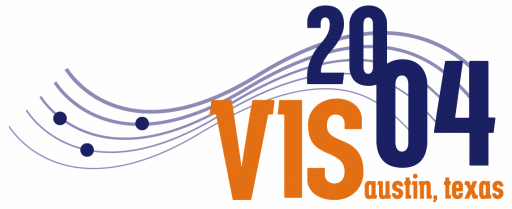IEEE Visualization 2004 Contest
Tasks
The theme for the inaugural IEEE Visualization contest was visualization fusion. The goal was to provide tasks which will allow researchers to showcase their visualization techniques from a wide range of disciplines. Since the type of information being shown is so diverse, we hoped to encourage collaboration of researchers from all domains of scientific and information visualization.
The task for this contest can be summarized in one sentence: design a visualization which allows interactive exploration of multiple characteristics of the given data set. The three elements of these tasks are explained in more detail below.
Interactive
The given visualization must be interactive. This means that the user can manipulate the view, change which time step is being used, etc. in as close-to real-time as possible. Modern graphics hardware, specialized data structures, and high-speed, interconnected visualization clusters could all be used for this sub-task. The task does not specify or limit what type of hardware/software must be used to fulfill this criterion.
Exploration
A task related to interactivity, the designed visualization must not be static. It must allow the user to change the parameters associated with the visualization technique in order to gain different understanding of the data. For example, a volume rendering method must allow the user to change the opacity map. The specification on how the user is allowed to change parameters is given; that is up to the system designer.
Multiple Characteristics
As the theme for this contest is visualization fusion, we are interested in visualizations with effectively combine multiple visualization techniques for the different variables in the data set. Below is a partial list of the types of information that could be extracted from the data and presented:
- Hurricane Structure: The clouds making up the hurricane; classification of portions of the hurricane (leading edge, eye, convective cells, etc.). How do these change when the hurricane makes landfall?
- Rainfall: Show the rainfall in the current time step; show the cumulative rainfall over the simulation.
- Wind: Show the strength and direction of the wind instantaneously; show the change of wind strength and direction over time. Show correlation between cloud formation and wind strength (is the cloud within area of maximum wind or not?).
- Temperature: Show the instant temperature values over the volume; show the change in temperature over the simulation.
- Water Vapor: Show the concentration of water vapor instantaneously and over time (including cloud moisture, snow pellets, etc.). How does the vapor relate to the air flow?
- Hurricane Properties: Show various properties of the hurricane. Visualize the changes in hurricane classification over time (e.g., tropical storm, category 5 hurricane, etc.). Depict the direction of the hurricane. Depict the area affected by the hurricane. How do these change when the hurricane makes landfall?
The above list is not inclusive, and not all of the properties discussed above must be shown concurrently. The characteristics shown, however, must tell a cohesive story. Do not just try to visualize everything; such visualization would be hard pressed to communicate anything about the data set.
Evaluation
There are two metrics for evaluation: the completeness of the supplied visualization and the effectiveness of the visualization. The effective measure has more weight than the completeness measure—a compelling, static rendering of multiple variables is more valuable then an reasonably interactive system with a less compelling suite of techniques.
Note that the various tasks for the contests set up competing requirements. Interactivity is often facilitated by smaller data sets with fewer visualization primitives, while the multiple characteristic criterion suggests more static but complex techniques. While we would like for submissions to attempt to handle all the requirements, submissions which focus on their strengths will be more valuable than incomplete attempts at the entire problem.
Evaluating Interactivity
Interactivity was determined by the video submitted as part of the contest submission. The video should have shown the visualization "running through its paces"—i.e., interactively stepping through the time steps and regions of the data.
A complete solution to the interactivity criterion would have been a visualization capable of rendering at real-time rates (10 frames-per-second) while depicting the entire data set. An effective solution might have had to compromise by sub-sampling the data either in space or in time or compromise on the rate of interaction.
Evaluating Exploratory Capabilities
The exploratory capabilities of the developed system must have been demonstrated in the video and discussed in the submitted web-page summary. A complete solution would have allowed all the parameters which control the visualization to be edited in some manner. An effective solution would have provided a some sort of advance capabilities to assist the user in performing this exploration.
Evaluating Multiple Characteristics Rendering
This criterion was the most important of the three as it related directly to the theme of the contest. A complete solution would have visualized all the properties discussed above; though all may not have been displayed at once, more than one should have been displayed at a time. An effective solution would have generated results which effectively communicate the variables under display—such a display would clearly tell the story of what occurred during the hurricane simulation. This part of the contest was evaluated based upon the submitted video and web-page.


